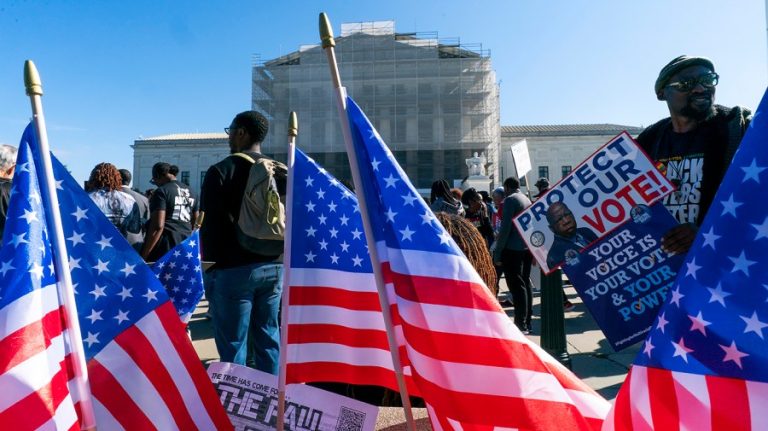The Supreme Court’s conservative majority has several avenues at its disposal as it appears poised to limit a central provision of the Voting Rights Act.
As the justices consider Louisiana’s congressional map, a rare reargument at the high court, expectations are growing that the Supreme Court’s decades-old framework that force states to draw additional majority-minority districts under the key provision will be reined in one way or another.
At the center of the arguments is Section 2 of the law, which prohibits voting practices that result in racial minorities having less opportunity to participate in the political process and elect representatives of their choice.
Republican-led states have increasingly criticized the Supreme Court’s framework for spurring endless litigation and pushing states to unconstitutionally consider race to comply.
Justice Brett Kavanaugh, during oral arguments earlier this month, repeatedly suggested ruling that race-based redistricting remedies have reached their logical end point. Kavanaugh raised it to three different arguing lawyers.
It’s a similar rationale to the court’s 2013 decision that struck down another Voting Rights Act provision, which created a formula to require jurisdictions with a history of discrimination to get preclearance from the Justice Department before enacting new voting rules.
It would also be in the vein of the court’s decision invalidating affirmative action in college admissions. When the court had endorsed affirmative action in 2003, it expressed an expectation that it wouldn’t be necessary in 25 years.
“This Court’s cases in a variety of contexts have said that race-based remedies are permissible for a period of time, sometimes for a long period of time, decades in some cases,” Kavanaugh said at last week’s argument. “But that they should not be indefinite and should have a end point.”
Justice Amy Coney Barrett, President Trump’s third conservative appointee to the court, focused on a different track.
The 14th Amendment allows Congress to enforce its guarantees of equal protection and due process, and the Supreme Court has held lawmakers’ remedies must be “congruent and proportional” to the rights being violated. Barrett suggested the test could be used to examine whether Section 2 of the Voting Rights Act is a valid exercise of Congress’ enforcement power under the 15th Amendment, which prohibits intentional discrimination in voting.
“If it’s going above and beyond what the 15th Amendment requires of its own force, but Congress has actually chosen the Voting Rights Act as a remedy, does that affect the question of whether it can go on indefinitely or not, that at some point it becomes not congruent and proportional?” Barrett asked at one point.
Justice Neil Gorsuch, Trump’s first appointee, repeatedly pressed whether it’s acceptable for a federal court to “intentionally discriminate on the basis of race” to fix a Voting Rights Act violation.
Meanwhile, Justice Samuel Alito largely questioned the specifics of Louisiana’s case and whether the lower courts had faithfully applied the court’s existing Section 2 framework — which requires a minority group to show it is sufficiently large and geographically compact enough to form a majority in a new district.
After lower courts ruled Louisiana’s map with only one majority-Black district violated Section 2, the state added a second one by creating a narrow path stretching from Baton Rouge in the southern part of the state to Shreveport, near its northwestern corner.
“There’s a big difference, and there’s a serious question about whether the Black population within the district in question in the illustrative map was geographically compact,” Alito noted.
And even before the current phase of Louisiana’s legal battle reached the justices, some members of the conservative majority have long endorsed broad changes to the court’s Section 2 approach.
Justice Clarence Thomas, the court’s longest-serving justice and an ardent proponent of a “color-blind Constitution,” has written for years that Section 2 only covers people’s access to vote and how their vote is counted, not the design of their electoral district.
As questions remain about what path the court will take, one dynamic has become increasingly apparent: the alliance that formed two years ago between may be splintering.
Rejecting a GOP-drawn congressional map in Alabama, Chief Justice John Roberts and Kavanaugh broke with their fellow conservatives and sided with the Supreme Court’s liberal wing — Justices Sonia Sotomayor, Elena Kagan and Ketanji Brown Jackson — to preserve the court’s Section 2 precedents.
“The heart of these cases is not about the law as it exists. It is about Alabama’s attempt to remake our §2 jurisprudence anew,” Roberts wrote at the time.
CNN later reported the behind-the-scenes dynamic. No solid majority had emerged when the justices took the initial vote at their conference following oral argument. As other conservative justices were prepared to rein in Section 2, Roberts reportedly later negotiated with Kavanaugh to form the slim 5-4 majority.
As the battle more recently turned to Louisiana’s map, the justices’ unusual decision to hear reargument in the case was widely viewed as a way to directly tee up the future of Section 2 with a broad lens.
“This case will test whether the arc of our universe still bends toward justice — or whether it has bent back upon itself,” Alanah Odoms, executive director of the American Civil Liberties Union of Louisiana, said in a statement.
The raised stakes became clear moments into the argument last week. NAACP Legal Defense Fund President Janai Nelson in her opening gave a full-throated defense of the two-year-old Alabama decision, Allen v. Milligan.
“That case, of course,” Roberts jumped in shortly after, “took the existing precedent as a given.”
Nelson told Roberts he was correct.
“I don’t think he feels like the Milligan decision really controls what he does here, and I think he wanted to make that clear,” said Jason Torchinsky, a partner at Holtzman Vogel who represents Louisiana Gov. Jeff Landry (R) in the case. “It was one of the very few things that he really probed about. But it was his first question.”
Roberts notched his 20-year anniversary on the Supreme Court last month, and one of his biggest legacies has been the conservative majority’s moves on race — in voting, education and more.
“It is a sordid business, this divvying us up by race,” Roberts famously wrote in a 2006 redistricting decision.
In considering Louisiana’s map, Roberts and the other justices are now explicitly weighing whether intentionally using race in drawing an additional majority-minority district to comply with Section 2 runs afoul of the 14th or 15th Amendments.
If the practice is barred outright, The New York Times estimated upward of a dozen Democratic-held districts across the South could be eliminated. Fair Fight Action, the group founded by former Georgia Democratic gubernatorial candidate Stacey Abrams, found it could create an additional 19 safe Republican seats.
No matter which path the Supreme Court takes, the Louisiana case has led observers on all sides to believe Section 2 is headed for major changes.
Anticipating the shift, Rep. Jonathan Jackson (D-Ill.) after attending the argument in the courtroom announced he was introducing a constitutional amendment alongside Rep. Ro Khanna (D-Calif) to counteract the court’s decision.
Louisiana Attorney General Liz Murill (R), who also attended, told reporters afterwards the court needs to “make some sense” of its own Section 2 precedents.
“And what we heard today is that that’s really hard — even for them,” she added.

